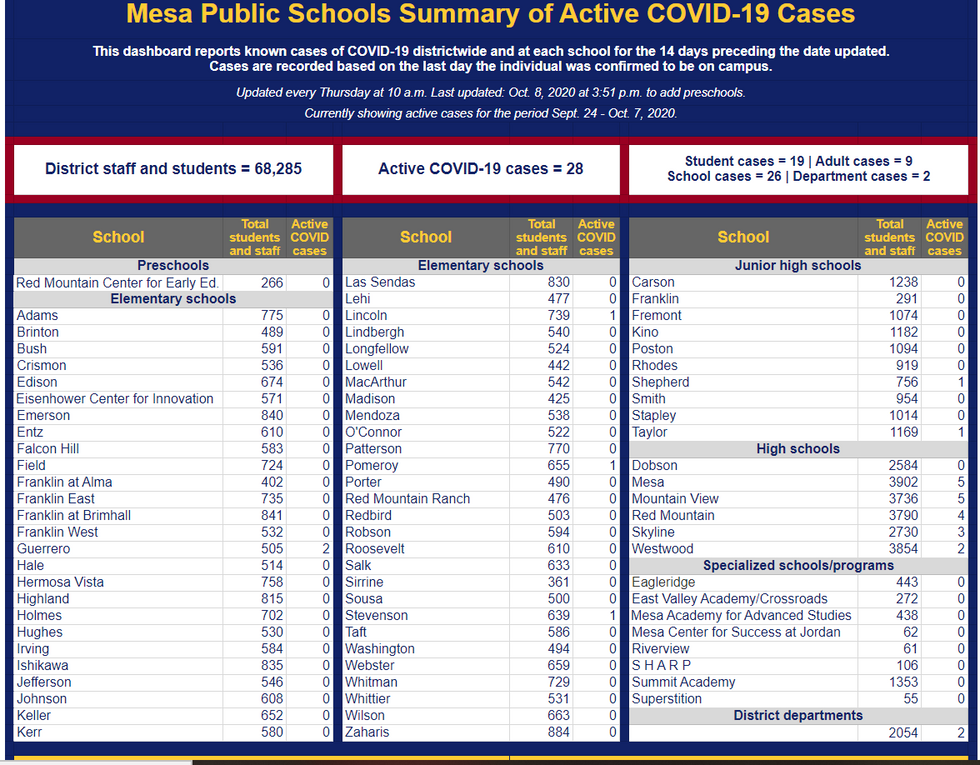"Yesterday was our third first day of school," said Mesa Public Schools Superintendent Dr. Andi Fourlis.
50.7 million Americans attend public school, and in the midst of a pandemic, navigating education for this highly populated demographic has become a hot topic of conversation.
Schools across the nation implement and continue various forms of in-person learning. But, just this week alone, many schools in the U.S. had to once again shut down due to the spread of COVID-19. To name a few, various schools in Pa., Mich., Conn., Tenn. and Calif. have switched back to a remote-only model.
And even with the start of flu season and a second wave of COVID-19 expected to hit the U.S. in the coming weeks, Arizona's largest school district, Mesa Public Schools, officially began its five-day in-person schedule on Monday, Oct. 12.
Transitioning From remote only, to modified in-person, to a current "traditional" schedule, Mesa Public Schools has developed ways to reduce anxiety, and maintain CDC guidelines.
Social distancing is also approached in creative ways. Some learning takes place outside, extra lunchtimes are added for more cafeteria space, even crowded halls are avoided by creating alternate routes to class.
"There was a great spirit and great conversation amongst our leaders, rethinking what learning spaces look like, so they can expand spaces and locations to physically distance to the very best of their abilities," said Dr. Flouris.
However, there is no denying that any in-person learning, especially schedules that allow students on campus for the whole school week, exposes a larger sum to possible infection.
"As we move to five days a week, we have more students on campus every single day and that contact becomes bigger," said Red Mountain High School teacher Joshua Buckley as he voiced the concerns of many at a Mesa Public Schools board meeting.
But Mesa Public Schools hopes to use transparency and communication as a way to reduce anxiety through the new COVID-19 Dashboard at mpsaz.org.
Open to the public, this dashboard updates every Thursday and shows two weeks' worth of data for every school in the district. The total population for each school is presented as well as the number of active cases of students and staff. Families of students are also notified within 24 hours of any active cases in the district.
"It tells a story of what's happening in the moment," said Associate SuperintendentHolly Williams when explaining the new dashboard.
Numbers are closely monitored and schools are prepared to transition back to remote learning at any time.
"Our biggest challenge moving forward is that we don't become too comfortable in going back to the good old days," said Dr. Flouris. "Our kids are waiting for us to reinvent what school look for them, and with them."
The "good old days" before COVID-19 seem like distant memories for all students in the U.S., but will this desire for normalcy put our nation's youth at risk? This question still awaits an answer as every school takes a different approach to this pandemic.




 Energetic dance performance under the spotlight.
Energetic dance performance under the spotlight. Taylor Swift in a purple coat, captivating the crowd on stage.
Taylor Swift in a purple coat, captivating the crowd on stage. Taylor Swift shines on stage in a sparkling outfit and boots.
Taylor Swift shines on stage in a sparkling outfit and boots. Taylor Swift and Phoebe Bridgers sharing a joyful duet on stage.
Taylor Swift and Phoebe Bridgers sharing a joyful duet on stage.








